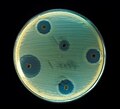Penicillium glaucum is a mold that is used in the making of some types of blue cheese, including Bleu de Gex, Rochebaron, and some varieties of Bleu d'Auvergne...
2 KB (222 words) - 04:56, 19 April 2024
blue cheeses. Other blue cheeses, such as Gorgonzola, are made with Penicillium glaucum. First described by American mycologist Charles Thom in 1906, P. roqueforti...
16 KB (1,694 words) - 22:03, 25 March 2024
of apples and other fruit, produces patulin Penicillium glabrum Penicillium glaucum, a mold that is used in the making of some types of blue cheese,...
23 KB (2,374 words) - 13:01, 5 September 2024
Blue cheese (section Penicillium roqueforti inoculum)
forming the curds that can then be made into blue cheese. Penicillium roqueforti and Penicillium glaucum are both molds that require the presence of oxygen to...
28 KB (3,227 words) - 19:25, 7 August 2024
History of penicillin (redirect from Discoveries of anti-bacterial effects of penicillium moulds before Fleming)
bacteria. He also described the antibacterial action on human tissue of Penicillium glaucum but did not publish his results. In 1875 John Tyndall demonstrated...
131 KB (16,722 words) - 23:46, 2 September 2024
used, to which starter bacteria are added with spores of the mould Penicillium glaucum. The Food and Drug Administration has established what is known as...
15 KB (1,187 words) - 15:30, 15 August 2024
perpetual battle for survival. In one experiment, he treated cultures of Penicillium glaucum with media containing either bacteria that cause typhoid fever (Salmonella...
8 KB (939 words) - 20:19, 20 June 2024
blue cheese is created by inoculating a cheese with Penicillium roqueforti or Penicillium glaucum. This is done while the cheese is still in the form...
21 KB (2,608 words) - 22:22, 24 July 2024
physician Sir William Roberts noted that cultures of the mould Penicillium glaucum that is used in the making of some types of blue cheese did not display...
155 KB (14,572 words) - 15:53, 31 August 2024
the use of one or more saprotrophic fungi, such as Penicillium roqueforti and Penicillium glaucum. Since the PDO came into effect, some British supermarkets...
25 KB (2,553 words) - 07:23, 19 August 2024
Penicillium gladioli Penicillium glabrum Penicillium glandicola Penicillium glaucoalbidum Penicillium glaucum Penicillium glycyrrhizacola Penicillium...
39 KB (2,221 words) - 15:25, 11 May 2024
versions[example needed] use a weaker form of mold, Penicillium glaucum, to create the blue veins, rather than the Penicillium roqueforti used in Roquefort and other...
4 KB (365 words) - 11:15, 21 August 2024
into moulds, Rochebaron is then pierced with wires impregnated with Penicillium glaucum to produce blue veins through the soft whitish body of the cheese...
1 KB (110 words) - 17:17, 11 January 2022
Penicillium expansum is a psychrophilic blue mold that is common throughout the world in soil. It causes Blue Mold of apples, one of the most prevalent...
14 KB (1,553 words) - 15:15, 22 July 2024
Bartolomeo Gosio. Gosio collected a fungus from spoiled corn and named it Penicillium glaucum. (The species is now called P. brevicompactum.[citation needed])...
40 KB (3,542 words) - 02:17, 16 June 2024
Edible fungi Edible molds Penicillium camemberti – used in the production of Brie cheese and Camembert cheese Penicillium glaucum – used in making Gorgonzola...
7 KB (505 words) - 12:10, 30 October 2023
antibiotic effect of "cellular products, soluble in water" extracted from Penicillium glaucum, Mucor mucedo and Aspergillus flavescens and sterilized in the experimentation...
237 KB (25,900 words) - 07:54, 29 August 2024
After reacting aqueous racemic ammonium tartrate with a mold from Penicillium glaucum, he reisolated the remaining tartrate and found it was levorotatory...
57 KB (6,914 words) - 13:54, 30 July 2024
a mold. He specifically studied the impact of Penicillium glaucum, a close relative of the Penicillium notatum. For this work, Roberts earned the Cameron...
4 KB (349 words) - 13:40, 25 March 2024
a fungus. He collected the fungus from spoiled corn and named it Penicillium glaucum. (But the species was later renamed P. brevicompactum.) In 1896 he...
8 KB (844 words) - 05:02, 2 August 2024
microscope. He identified three species of molds: Aspergillus flavescens, Penicillium glaucum, and Mucor mucedo. He then prepared an aqueous extract of the individual...
11 KB (1,395 words) - 16:17, 7 October 2023
gladioli Machacek. Penicillium glaucum Link. Penicillium gratioti Sartory. Penicillium guttulosum Abbott. accepted as Penicillium simplicissimum Thom...
124 KB (7,472 words) - 03:02, 26 March 2024
glandulosum Ames 1923 Bulbophyllum glaucifolium J.J.Verm. 1991 Bulbophyllum glaucum Schltr. 1913 Bulbophyllum glebodactylum (W.Suarez & Cootes) Sieder & Kiehn...
120 KB (13,537 words) - 00:38, 18 March 2024


















